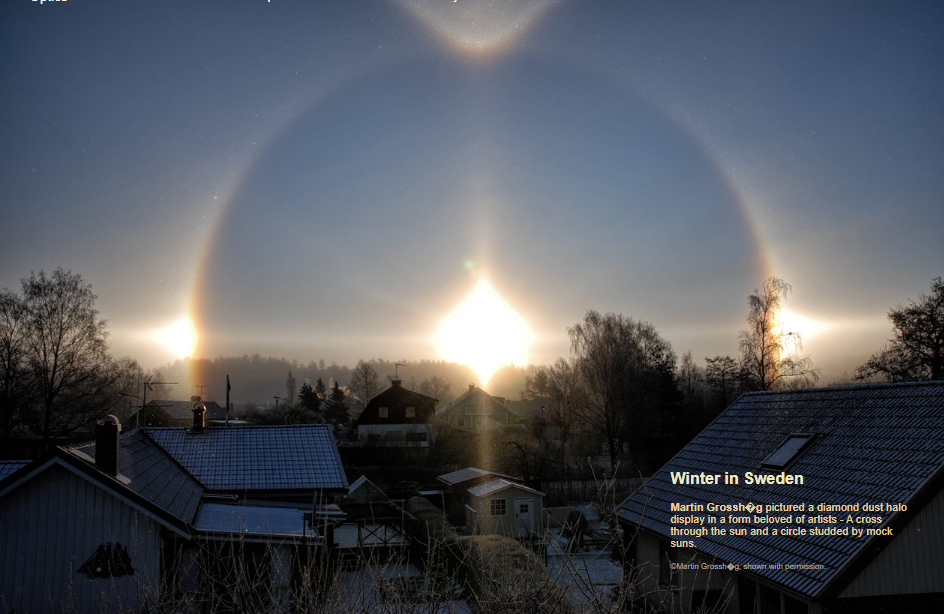OPOD - Sweden, Winter
OPOD - Sweden, Winter: A Stunning Display of Atmospheric Optics
In the breathtaking landscapes of Sweden during winter, Martin Grosshög captured a mesmerizing atmospheric optics phenomenon. The images reveal a diamond dust halo display, showcasing a magnificent cross through the sun and a circle adorned with mock suns. These ethereal formations are created by the interaction of sunlight with ice crystals suspended in the air.
The intricate display can be dissected into various components, each contributing to the overall spectacle. Let's explore the fascinating features of this winter phenomenon in Sweden:
Glints of Ice Crystals and Sun Pillars
When observing the full-sized view of the display, one can witness the individual glints of ice crystals. These crystals, shaped like hexagonal plates, extend downward from the sun and create a stunning sun pillar. The hexagonal shape of the crystals causes light to refract, forming the outer 22° halo that encircles the sun.
Upper Tangent Arc and Sun Pillars
Horizontal column crystals play a crucial role in the display by producing an impressive upper tangent arc. Additionally, they contribute to the formation of both upper and lower sun pillars. The hexagonal end faces of these crystals reflect light internally and externally, enhancing the illumination of the parhelic circle.
Bright 'Mock Suns' or Sundogs
Plate crystals, with their distinctive shape, give rise to the bright "mock suns" known as sundogs. These captivating optical phenomena are seen on either side of the sun and add to the beauty of the display. Furthermore, plate crystals also contribute to the formation of sun pillars and the parhelic circle.
The Encircling 22 Degree Halo
Randomly oriented crystals of various forms contribute to the creation of the encircling 22° halo. These crystals refract rays in different directions, resulting in a ring of light surrounding the sun. The combination of different crystal orientations adds complexity and depth to the atmospheric optics display.
Exploring the Beauty of Atmospheric Optics in Sweden
The captivating images captured by Martin Grosshög in Sweden during winter provide a glimpse into the stunning world of atmospheric optics. The intricate interplay between sunlight and ice crystals produces a breathtaking spectacle that enchants both artists and nature enthusiasts alike.
Conclusion
The diamond dust halo display observed in Sweden during winter showcases the incredible beauty and complexity of atmospheric optics. From the cross through the sun to the circle studded with mock suns, each element of the display can be attributed to specific types of ice crystals and their interactions with sunlight. These mesmerizing phenomena serve as a reminder of the wonders that nature can create, captivating our imagination and leaving us in awe of the world around us.

Winter in Sweden
Martin Grossh�g pictured a diamond dust halo display in a form beloved of artists - A cross through the sun and a circle studded by mock suns.
©Martin Grossh�g, shown with permission.

In this full size view we see the individual glints of the ice crystals.
Extending downwards from the sun, hexagonal plate crystals glint to form a sun pillar. More randomly oriented crystals refract rays to form the outer 22° halo.
A HaloSim ray tracing reproduces the display's main features.
Horizontal column crystals produced the impressive upper tangent arc. They also contributed to the upper and lower sun pillars. Internal and external reflections from their hexagonal end faces helped light the parhelic circle.
Plate crystals gave the bright 'mock suns' or sundogs. They too contributed to the pillars and parhelic circle.
Randomly oriented crystals of some form made the encircling 22 degree halo

Note: this article has been automatically converted from the old site and may not appear as intended. You can find the original article here.
Reference Atmospheric Optics
If you use any of the definitions, information, or data presented on Atmospheric Optics, please copy the link or reference below to properly credit us as the reference source. Thank you!
-
<a href="https://atoptics.co.uk/blog/opod-sweden-winter/">OPOD - Sweden, Winter</a>
-
"OPOD - Sweden, Winter". Atmospheric Optics. Accessed on November 26, 2024. https://atoptics.co.uk/blog/opod-sweden-winter/.
-
"OPOD - Sweden, Winter". Atmospheric Optics, https://atoptics.co.uk/blog/opod-sweden-winter/. Accessed 26 November, 2024
-
OPOD - Sweden, Winter. Atmospheric Optics. Retrieved from https://atoptics.co.uk/blog/opod-sweden-winter/.